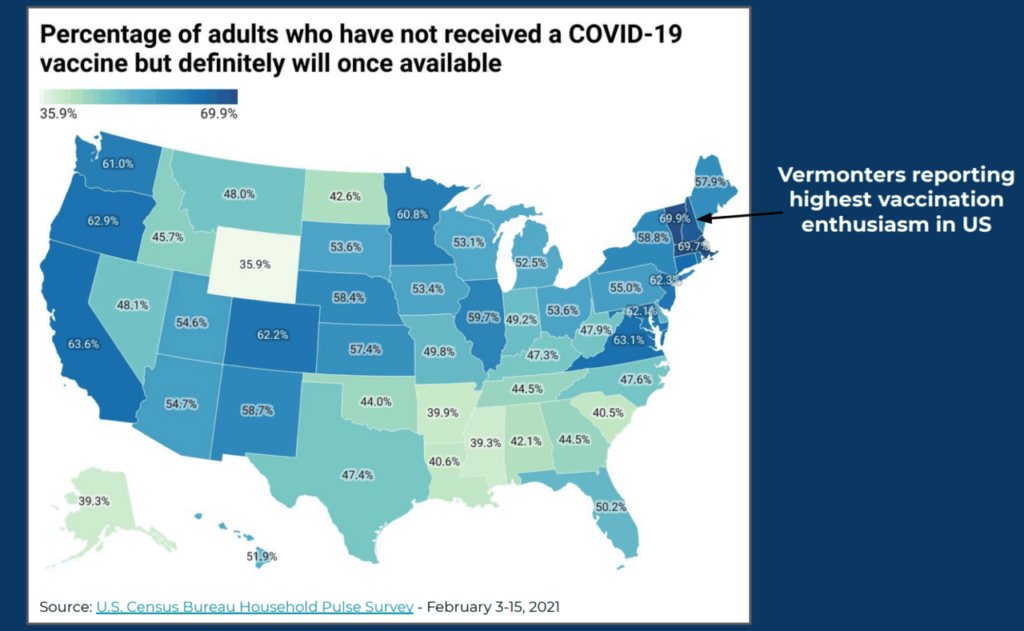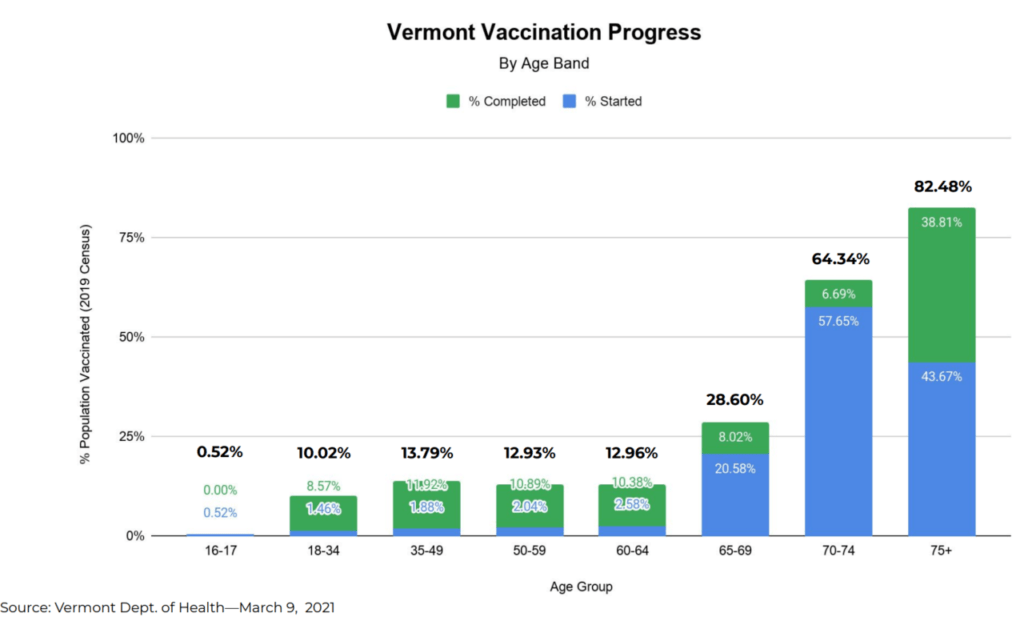Restrictions on gatherings loosen again for vaccinated Vermonters
By Polly Mikula
Because of the increased supply and lower than expected enrollment in the 55+ group with high risk conditions (phase 5a), the state is opening up registration for 16+ with high risk conditions (5b) early, Governor Phil Scott announced Tuesday, March 9. Vermonters age 16+ with qualifying conditions can now enroll Thursday, March 11, four days earlier than previously announced. In total, the state estimates that groups 5a and 5b include about 75,000 Vermonters — all deemed to be high risk.
“We want to be sure we get to them as soon as possible,” Scott said.
Despite having a fewer than expected sign up for 5a, the state has performed very well, thus far, with its vaccination program. Vermont is currently third in the Northeast and 13th nationally for its rate of vaccination with 31.85 doses administered per 100 residents. It ranks 11th nationally by percent of population fully vaccinated.
Vermonters also report the highest vaccination enthusiasm in the U.S. according to a Census Bureau report Feb. 3-15, with 69.9% of Vermont adults who have not yet received a Covid-19 vaccine saying they “definitely will once available.”
“The good news is, so far, we’ve seen a high up-take rate,” Scott said, Tuesday. “Over 80% of those in the 75+ age band having received at least one dose… the high acceptance rate is something that we need to continue to strive for, so let’s keep it up by signing up when it’s your turn.”
Simultaneously, this week, the state opened up eligibility for vaccination to teachers and childcare workers, hoping to encourage a return to full in-person instruction.
On Monday, vaccination sites opened in seven school districts: Barre, Bennington County, Harwood Union, North Country, Mill River, Rutland City and Springfield.
Additionally, details of at least 28 additional school clinics are being finalized and should go online in the coming weeks, said Mike Smith, secretary of the Agency of Human Services.
Scott said once Vermonters with high-risk conditions and teachers, child care workers, police, first responders and corrections employees are able to get vaccinated, he hopes the state returns to an age-banding system, either in five- or 10-year increments, beginning with Vermonters age 60-65.
“It’s the simplest and most effective way that we have found,” Scott said of the age-banding strategy. “We’re seeing many other states’ governors call and ask how we’re doing what we’re doing. Many are going to age-banding after abandoning their strategy for other populations,” he said.
Because the vaccine supply is expected to expand rapidly, Scott said it’s possible that most Vermonters will get the vaccine “much sooner than we originally could have hoped for.”
As of March 9, the state reporting 23.2% of Vermonters age 16 and up have had at least one dose of the vaccine, or 127,454 people; with 68,900 have gotten their second dose.
Within a month, Scott said, a third of Vermont’s eligible population could be vaccinated.

Vaccinated gatherings
Vermonters who are fully vaccinated against Covid-19 can gather with other people who are vaccinated — in groups of any size — Gov. Phil Scott announced Friday, March 5. Those Vermonters can also gather with one additional household that is not vaccinated.
“For example, if eight fully vaccinated individuals want to gather, they can do so, and bring one other household that’s not vaccinated,” Scott said.
The CDC announced similar guidelines Monday, March 8.
“I was happy to see that Vermont is once again ahead of the curve when it comes to deliberate easing of guidelines while still maintaining important protections like mask protocols,” State Health Commissioner Dr. Mark Levine said. “This [CDC] guidance includes: you can stay indoors with fully vaccinated people without wearing a mask or staying 6 feet apart and you can gather indoors with unvaccinated people from one other household (for example visiting with relatives who all live together without masks) unless any of those people or anyone they live with is at an increased risk of severe illness for Covid-19. If you’ve been around someone who has Covid-19, you do not need to stay away from others or get tested or quarantine unless you have symptoms,” he continued. “But vaccinated people should still take steps to protect yourself and others in many situations, like wearing a mask, staying at least 6 feet apart and avoiding crowds whenever you are in public.”
CDC did not make any changes to its travel guidance or recommending gatherings, even for vaccinated people, Levine noted.

Wasted vaccine
Wastage, or the amount of vaccine lost or non-viable, is a concern all Vermonters and institutions share, Levine said. And while no system is perfect, Vermont is doing well.
Thus far, there have been 458 non-viable doses, or about 0.2% of the vaccine the state has received, Levine said. Far less than the CDC standard of less than 5%.
“There are always errors that result in a lost dose, including accidents, problems with equipment, as well as issues with planning,” Dr. Levine said, Tuesday. “But I want to make it very clear that there is no person, program or facility that wants a single dose to go unused.”
Opening the spigot
At Tuesday’s press conference, the governor said he expects to “open the spigot” even further, with another easing of restrictions to be announced Friday, March 12.
Scott said, “Overall we’ve done very well,” citing hospitalizations and deaths continuing to decline, spring weather allowing people to get outside more and high vaccination rates. “We do see light at the end of the tunnel. We’ll do it in a methodical and very disciplined way… one small step at a time,” he said.





